An F-22 Raptor belonging to Edwards Air Force Base’s 411th Test and Evaluation Squadron has been flying around with stealthy enclosures hanging off its under-wing hardpoints. This is the first time we have ever seen the Raptor equipped with such a unique installation. It points to how the F-22 program seems to be rapidly evolving to maintain its potency into the 2030s, before it is expected to be replaced by the Next Generation Air Dominance (NGAD) family of future air combat systems.
The beautiful images of the Raptor in question — serial number 06-0132 — were taken by aviation photographer James Reeder, who goes by @boreeder on Instagram, at the Air Force’s Plant 42 facility in Palmdale, California, during the middle of the day. In other words, this F-22 was not hiding in the shadows. Photographers are a common staple at the famed airfield. Plant 42 also happens to be home to Lockheed Martin’s Skunk Works advanced projects division, which originally developed the Raptor.
The aircraft was also covered in test markers that are common to the flight test environment. Multiple seams and panels appear to have been serviced or scabbed over recently, which is also a common sight for the test Raptor force.
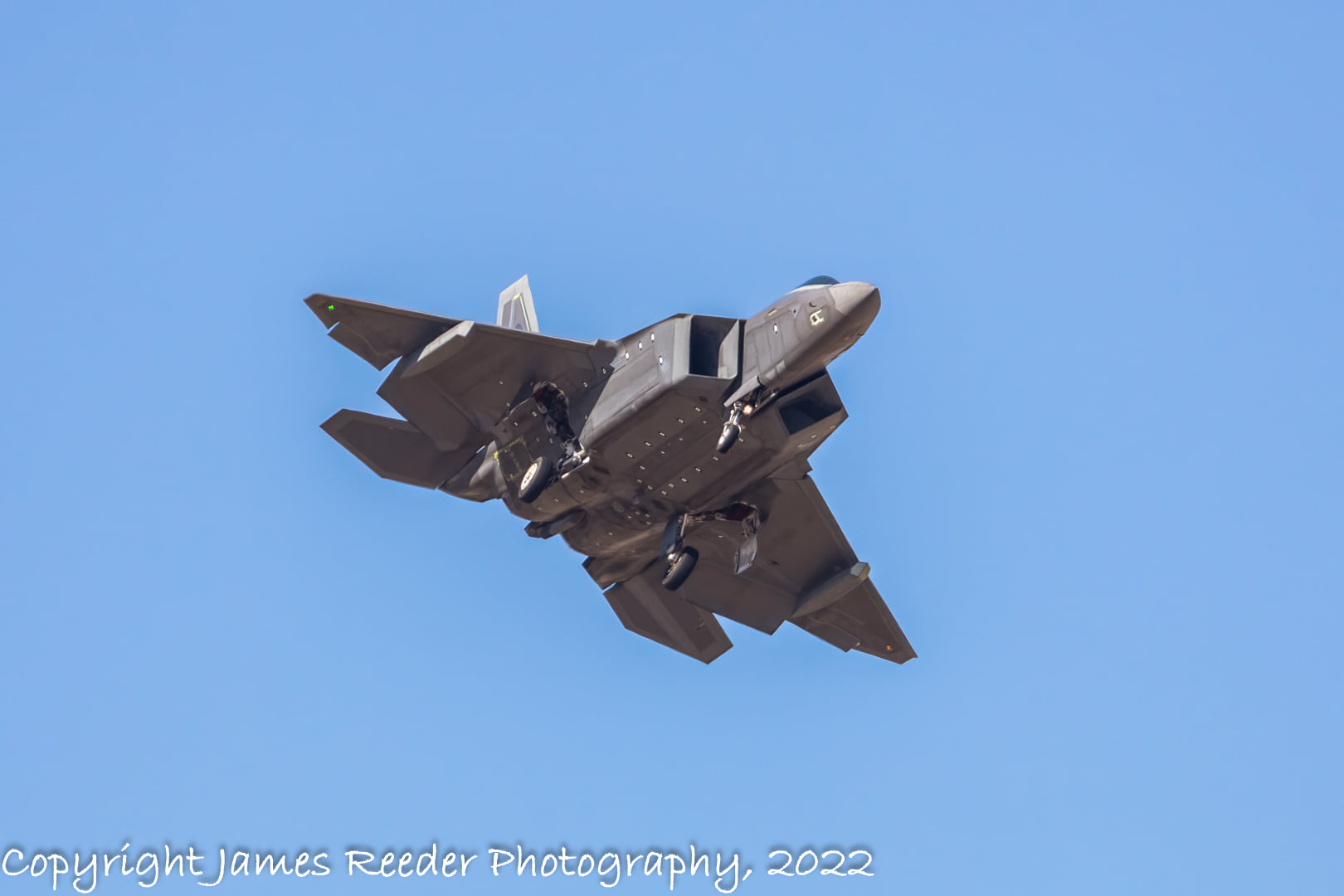
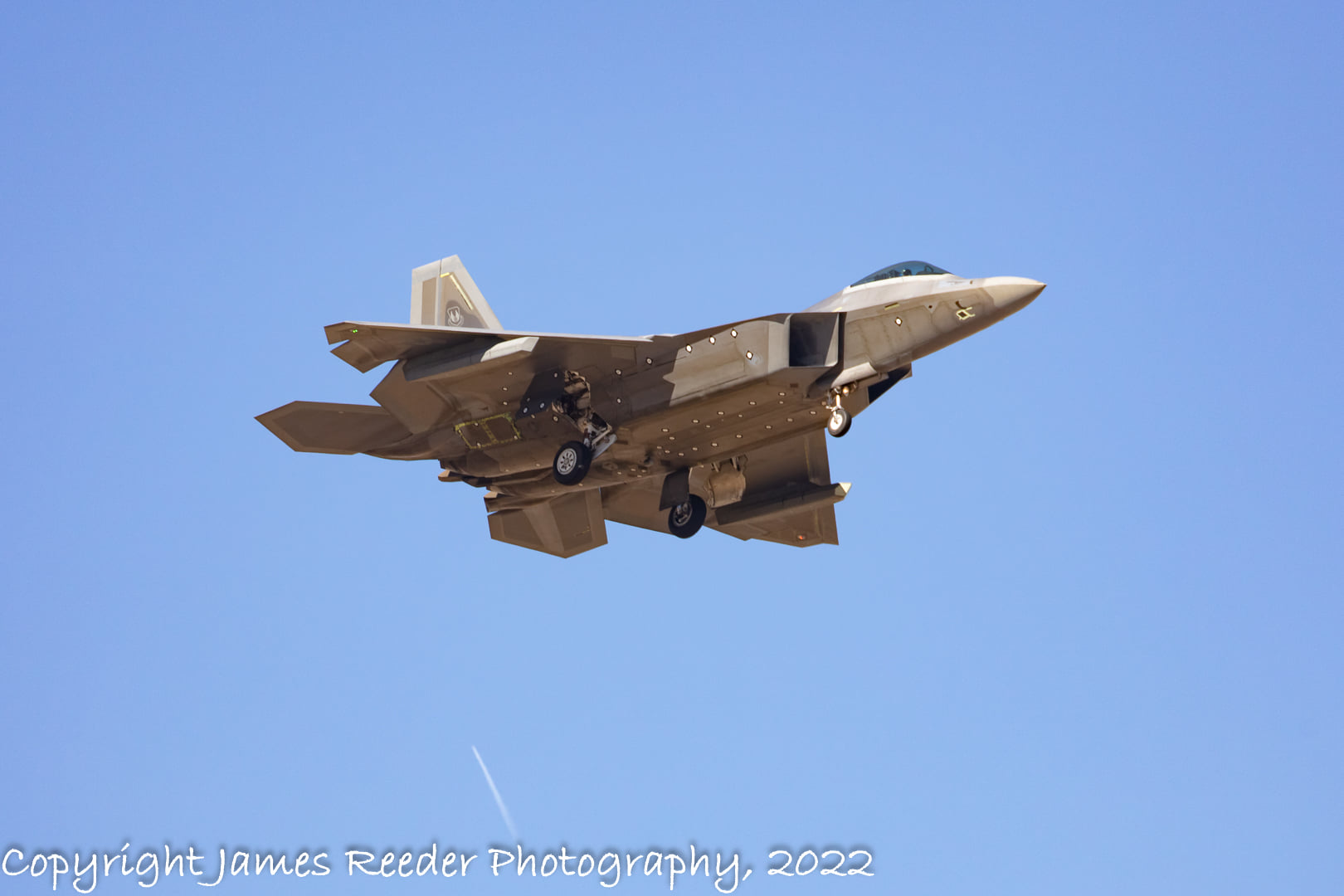
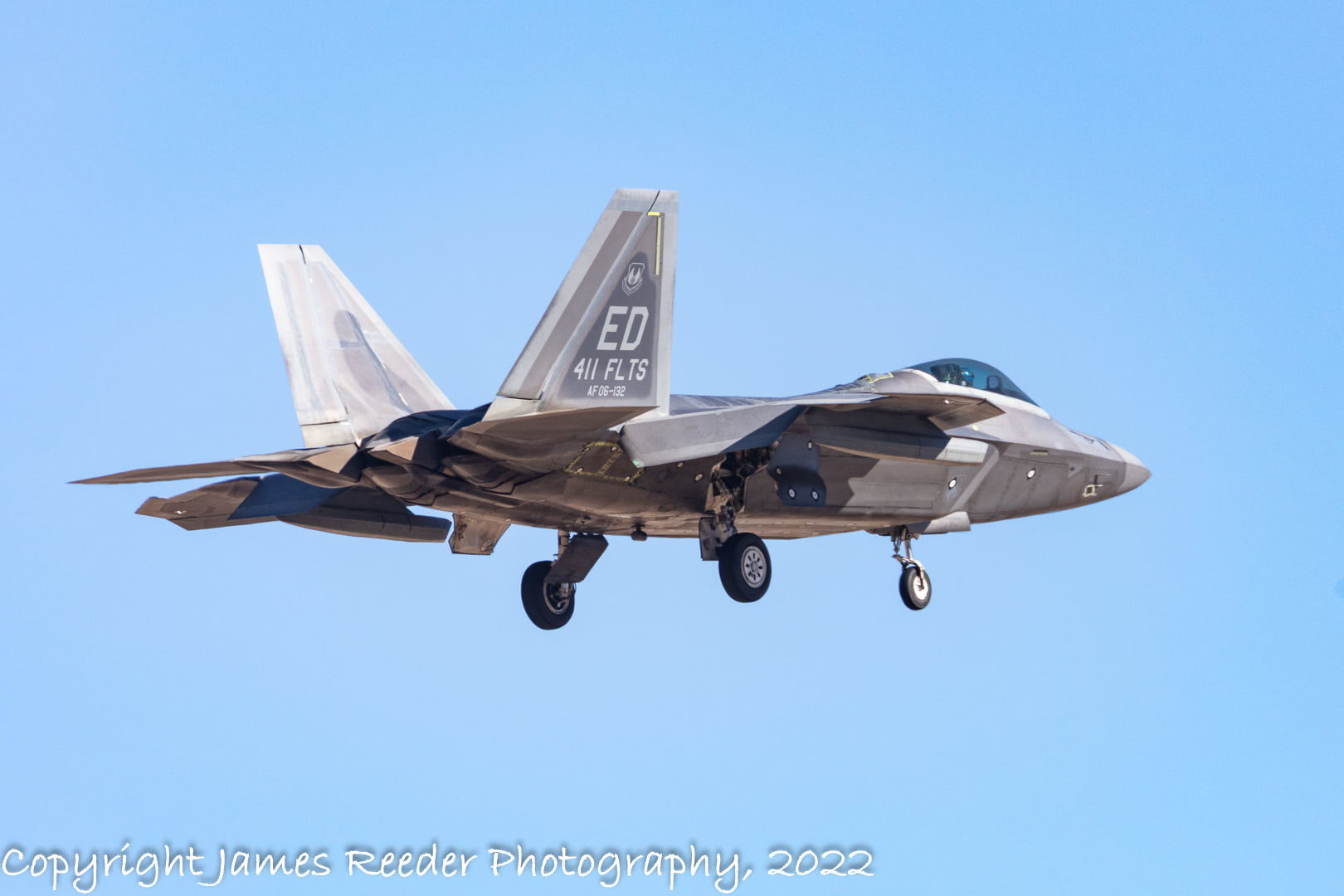
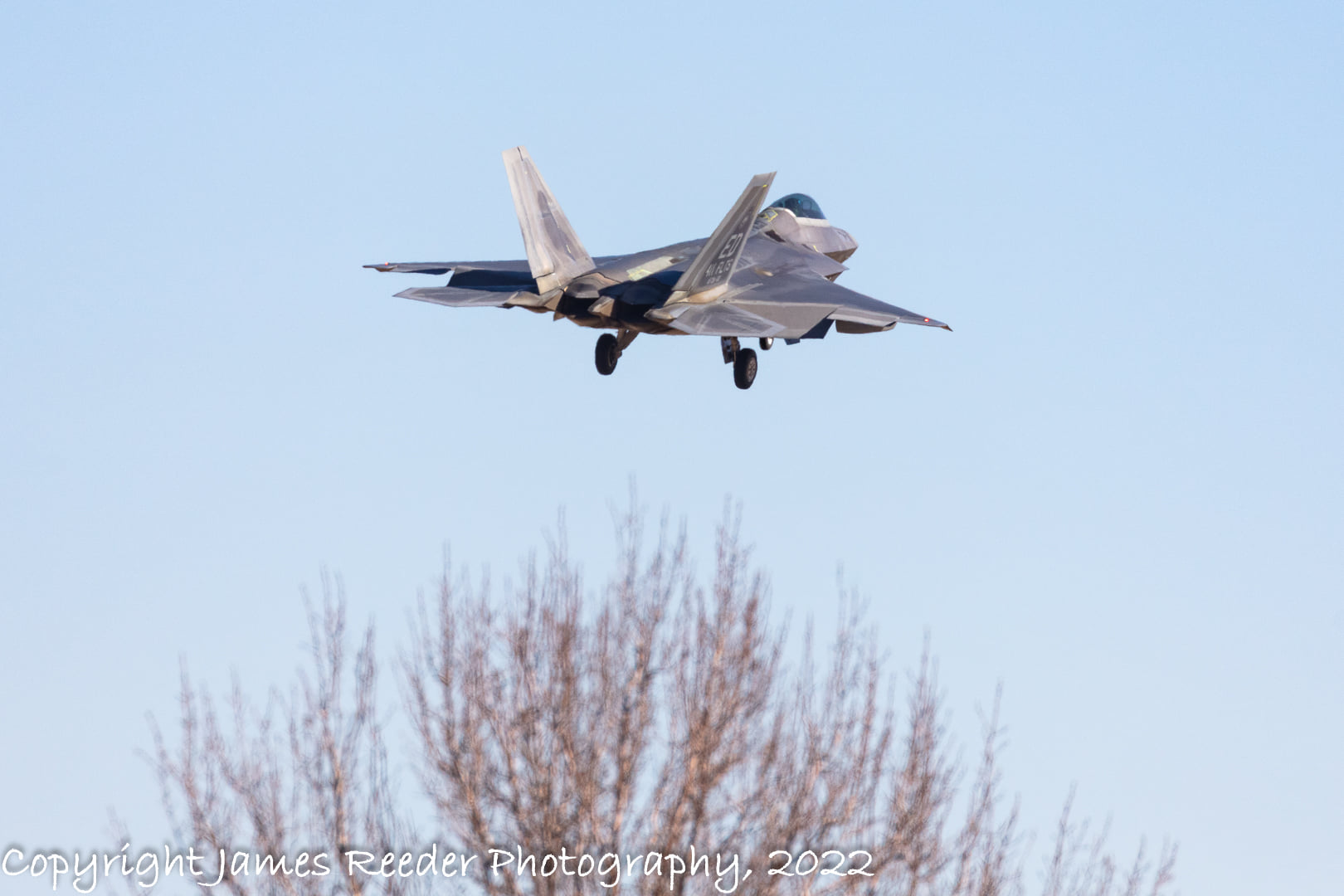
While F-22s commonly fly ferry and homeland air sovereignty missions with external fuel tanks, and we have seen them with missiles hung from their underwing hardpoints for testing, this is the first time we have seen an F-22 with any sort of a bolt-on low-observable enclosure. Yet the idea certainly isn’t a new one, which we will get to in a moment.
Aside from things that outright negate the F-22’s low-observable qualities, like missile rails with missiles attached and large fuel tanks, adding anything that changes its outer mold line demands a delicate balancing act between radio-frequency signature reduction and major capability enhancements. It’s always a tradeoff, but, with the F-22 entering the back half of its service life, certain capabilities may very well be worth trading a little ‘stealth’ for. In fact, doing so could result in a substantially more survivable, deadly, and relevant Raptor.
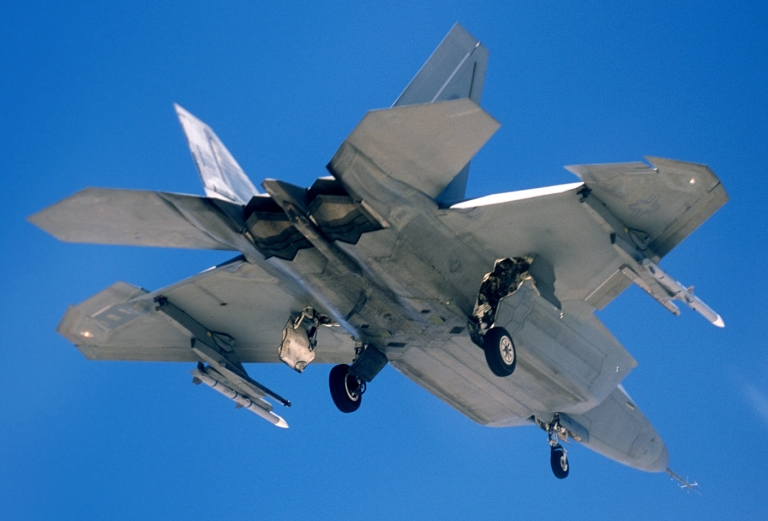
This may very well be the case with the mirror-like coating we have seen the F-22, and now other stealthy aircraft, including the F-117 and F-35, fly with as of late. Even if that skin treatment degrades the aircraft’s ability to hide from some radars to a degree and makes it easier to be spotted by the naked eyeball, it may significantly reduce the distance that infrared sensors could detect it. Those sensors are becoming a major threat to all aircraft, and especially stealthy ones, on the modern battlefield. While this is just conjecture, it illustrates the tough decisions that may have to be made to keep America’s super fighter at the top of the aerial combat food chain.

A similar set of circumstances seems to be very much in play here. While adding pods under the Raptor’s wings is bound to degrade its tiny radar signature, especially from certain aspects and radar bands, by carefully contouring the pods to maximize their own low-observable potential, those negative impacts can be mitigated.
Regardless, trading some radar-evading capabilities to allow the Raptor to gain other survivability and offensive enhancements may be essential to its future utility, especially as integrated air defense systems (IADS) that link disparate sensors together across the battlespace are proliferating and will be increasingly capable of blunting a stealthy aircraft’s ability to evade detection at shorter distances. This is particularly true for low-observable tactical aircraft, like the F-22, that were designed decades ago, when individual X-band fire control radars were the primary threat they were designed to evade and IADSs were far simpler networked affairs than they are now.
Due to advances in computing, datalinks, and data fusion, as well as major leaps in sensor performance across the board, this has drastically changed. For instance, AESA radars, which can spot smaller and stealthier targets at greater distances, and that were largely exclusive to the U.S. when the F-22 entered service, have now proliferated around the globe and America’s enemies are equipping their platforms with them en masse.
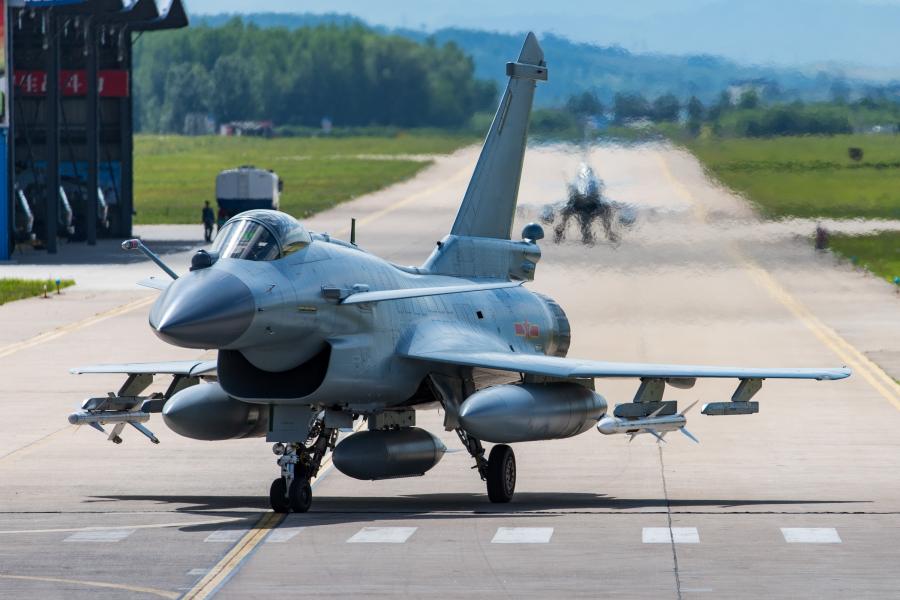
It’s a classic case of changing with the times and adapting what was the state of the art decades ago to the realities of today’s battlespace. The USAF has been forthcoming about its interest in doing this with the F-22, identifying a number of wants for the jet. These include the following, and there may be others that are kept in the classified realm:
- Integrating the Thales Scorpion helmet-mounted display/weapon cuing system
- A long-range infrared search-and-track sensor
- Manned-unmanned teaming
- Pilot-assisted autonomy
- A GPS-alternative navigation system
- Simulation of “red air” threats
- Algorithms for “optimized intercepts”
- Combat identification of threats
- Cyber intrusion detection and prevention
- Predictive maintenance
- Synthetic data generation
- Sensor fusion
- Improved sensing
- Real-time debriefing
So, with all that in mind, what could these pods be for? We don’t know that answer for certain, but there certainly are some clear possibilities.
The first thing that comes to mind is that they represent a new advanced electronic warfare capability that can be largely bolted onto the F-22. The pods themselves look similar to self-escort electronic warfare pods in service today, such as Elta’s popular 8222 series. Of course, this is one example. Any system would have to be tailored to the F-22’s existing mission systems and installed in the low-observable pods that leverage stealthy RF aperture technology.

Usually, just one pod is carried, but a more robust system could allow F-22’s to provide defensive and offensive electronic attacks, and even trigger cyber attacks, for itself, other Raptors in its flight, and other friendly aircraft in its vicinity. The Raptor already has a highly-capable electronic support measures (ESM) system with electronic warfare (EW) capability. Its integrated AN/ALR-94 system can geolocate and classify threat emitters all around the F-22 and has some electronic warfare capabilities, as well. Seeing that Raptors can operate at upwards of 65,000 feet, an upgraded ESM/EW suite could take advantage of its high perch. With new weapons in the works, giving the Raptor an enhanced ESM/EW capability would also allow it to work more effectively in supporting the destruction/suppression of enemy air defense mission set.
In addition, a highly-capable electronic warfare upgrade would potentially be worth trading some low-observability on the F-22 for the reasons we already mentioned. It would provide another layer of protection for operations deep into contested airspace, where the Rator was born to fight. An electronic warfare pod could also potentially provide secondary communications and other sensor functions if it is based on an AESA. It’s thought that the F-22’s AN/APG-77 AESA radar already has some secondary electronic attack functions, so combining it, along with the rest of the aircraft’s situational awareness enhancing systems, a new podded electronic warfare system upgrade could result in an incredibly potent capability that could possibly go well beyond providing self-protection.
Another possibility, a high one at that, is that at least one of the pods could house an infrared-search and track (IRST)-like system behind a faceted window. This would give the F-22 the IRST it was originally promised without having to go through the very costly exercise of changing the aircraft’s outer mold line and even rearranging some of its internal components. We know that the Air Force wants to give the F-22 an IRST-like system as part of the aforementioned potential future upgrades. Once again, the F-22’s high perch would really give its IRST a great point of view. You can read all about the F-22’s IRST saga and the initiative to finally give it that capability in this recent piece of ours.
It’s worth mentioning that the idea of trying to install such a system internally, as it was originally envisioned at the start of the Advanced Tactical Fighter program that gave birth to the F-22, would be highly problematic and isn’t really an option. This leaves a podded IRST as the most likely alternative. From our recent report on the Air Force’s wish to integrate an IRST into the F-22:
Back in 2017, Ken Merchant, who was then Lockheed’s vice president for the F-22 program, told Air Force Magazine that “we really don’t have the real estate” to fit an internal IRST in the jet, at least in an installation comparable to the Electro-Optical Targeting System (EOTS) in the F-35.
“We’re looking at other options,” Merchant said at the time, but he was unable to provide more details due to classification.
In fact, having one pod be an electronic warfare expansion capability and the other an IRST would give the F-22 an extremely potent upgrade, even if it degrades its stealthiness from certain aspects. One or two F-22s equipped with this configuration could be huge force multipliers for other F-22s in the battlespace, as well as other aircraft.
With that in mind, the possibility that these pods represent just such a configuration, with an electronic warfare capability on one side and an IRST on the other, looks more likely than not. The pod on the F-22’s left wing does look like it has a different faceted nose area than the other, almost as if it is meant to be a transparent window, while the other is opaque.
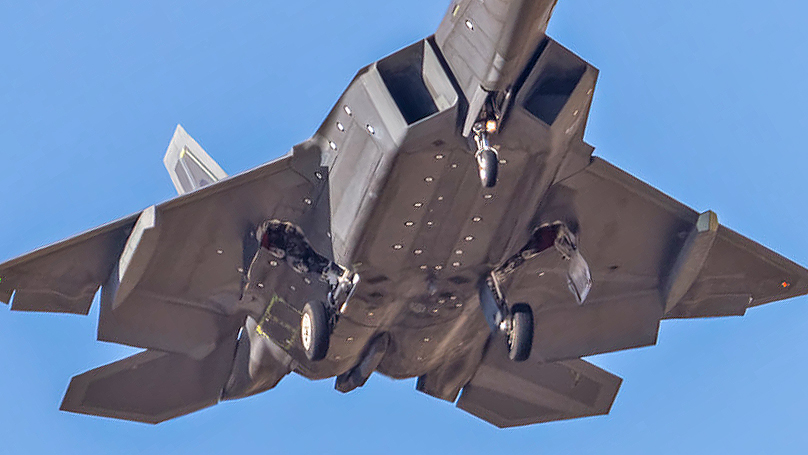
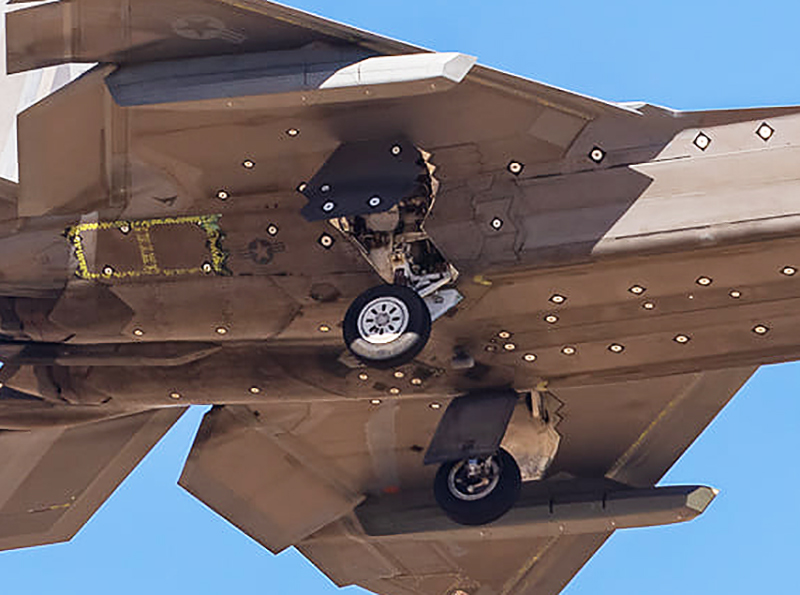
It’s also worth noting that the nose shape and treatment look similar to fixed low-observable optical enclosures we have seen elsewhere, such as on Naval Strike Missile, AGM-84H/K SLAM-ER. Even some concepts for the original F-22’s IRST enclosure looked similar.
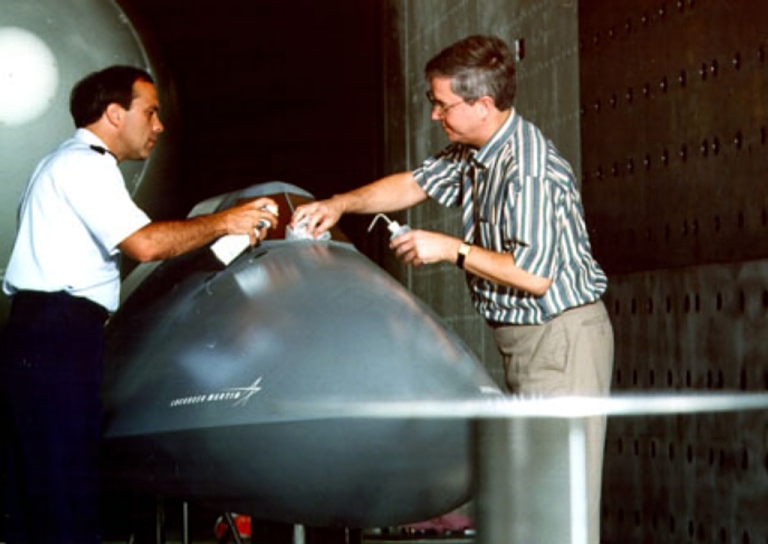
Once again, the pairing of these two capabilities would represent a massive leap in the F-22’s baseline capability. The fact that they could be fitted as needed depending on the threat is also quite attractive. Only one or two Raptors in a flight would need to carry the system, with the two only being beneficial for rapidly triangulating a track’s exact position that the IRST detects. Two aircraft spaced apart are just much more capable at this, although it can still be done with one aircraft, especially with the help of the F-22’s other sensors.
The EW capability would have to conform to the F-22’s low-probability of intercept (LPI) emissions control measures in order to keep the aircraft’s presence and position hidden as much as possible from the enemy. Most of the Raptor’s radio-frequency systems, including its AN/APG-77 radar, use LPI tactics to great effect. But with an IRST in the mix, a flight of Raptors could hunt passively, giving off very little emissions at all, regardless of LPI or not. Paired with the jet’s own ESM suite, it could give the F-22’s a whole new way of silently prosecuting enemy targets. Once again, we are talking about a big force multiplier here.
It’s also worth noting that this configuration could be intended to be used in the adversary role, in which the F-22 plays the enemy aircraft. Pushing Raptors into this role and giving them better tools to execute it is also on the Air Force’s wishlist. It’s possible an IRST and/or electronic warfare/threat emulation pods could be used for that role, even if they could be used in actual combat, as well. This would give the Raptor the ability to replicate aircraft like the J-20, which features a similar infrared sensor capability.
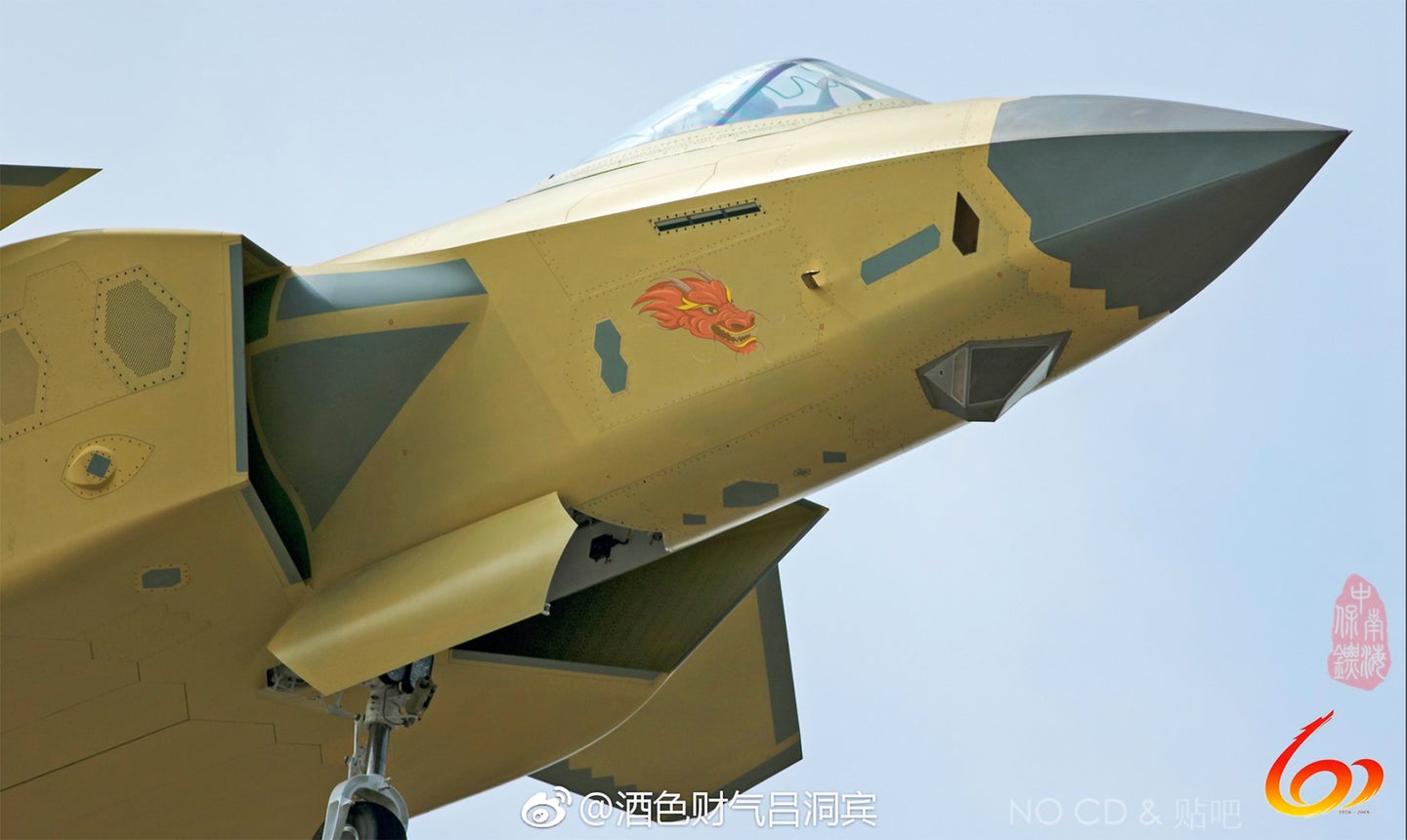
There are other possibilities, including data-link capabilities — something that has long been a thorn in the F-22’s side, even though its inability to talk with other assets is getting closer to being solved through various means. Carrying its own pod to translate its proprietary LPI Intra-Flight Data Link (IFDL) into other waveforms, such as the F-35’s Multi-Functional Data Link (MADL) would be very advantageous. In the past, this has required a 3rd party gateway carried by another platform altogether. An organic onboard gateway capability could still be paired with an IRST. In fact, the Talon Hate pod, which was something of an experimental affair, did just that for the F-15. Splitting those capabilities in two into low-observable enclosures for the F-22 would make sense.
Then there is the question of more weapons. Considering the design of these pods — they just are not that big — this possibility seems less likely, but there are small hit-to-kill air-to-air missiles in the works as well as miniaturized air-to-ground weapons and even air-launched drones that could possibly be accommodated by such a design. An extra AIM-9X under each wing would also give the F-22 a big upgrade in firepower — the AIM-9X is much more than just a dogfighting missile, especially in its Block II+ form. And more missiles are always at the top of any Raptor pilot’s wishlist. But that would be a tight fit and these pods don’t really look built for that.
Air-to-ground weaponry is another story. The ability to carry even four more Small Diameter Bombs, or even small drones that can jam and attack threat radars, could be highly beneficial. And once again, the concept of low-observable weapons pods for the F-22 is not new. During the Raptor’s development, similar pods were researched and even tested in wind tunnels. Later on, the FB-22 concept, at least a number of variations of the idea, leveraged stealthy underwing weapons ‘canoes’ to expand its weapons carrying capabilities.
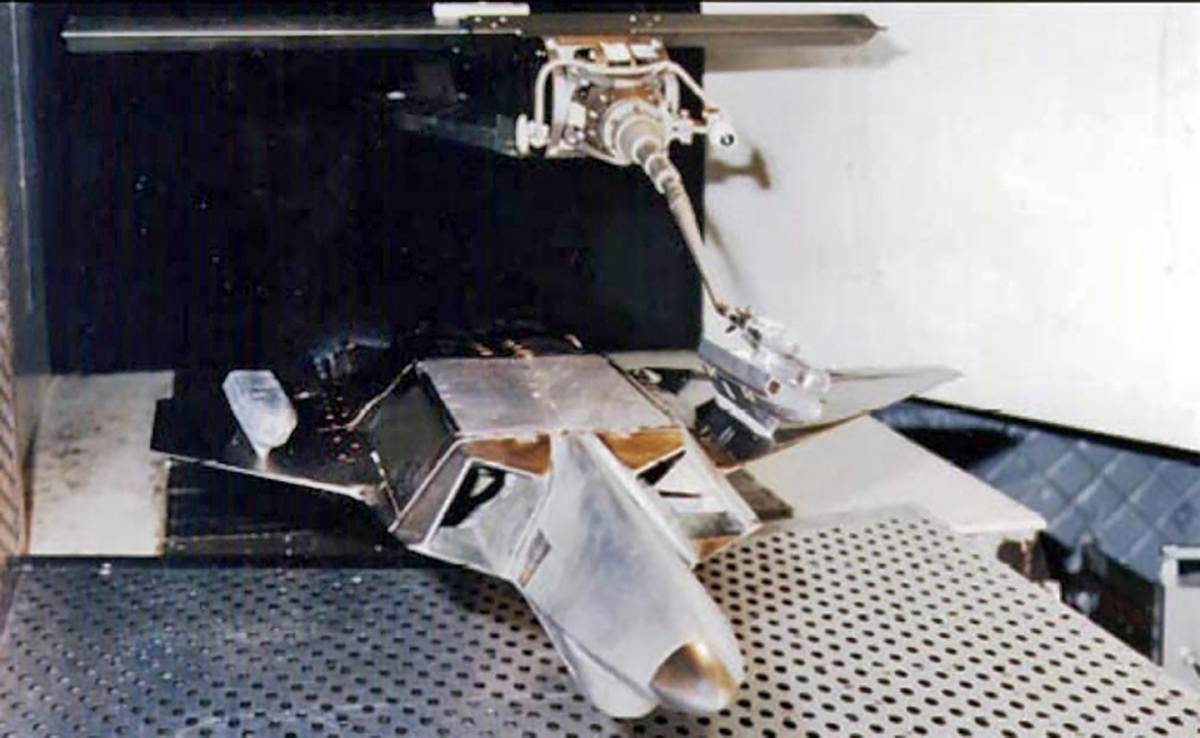
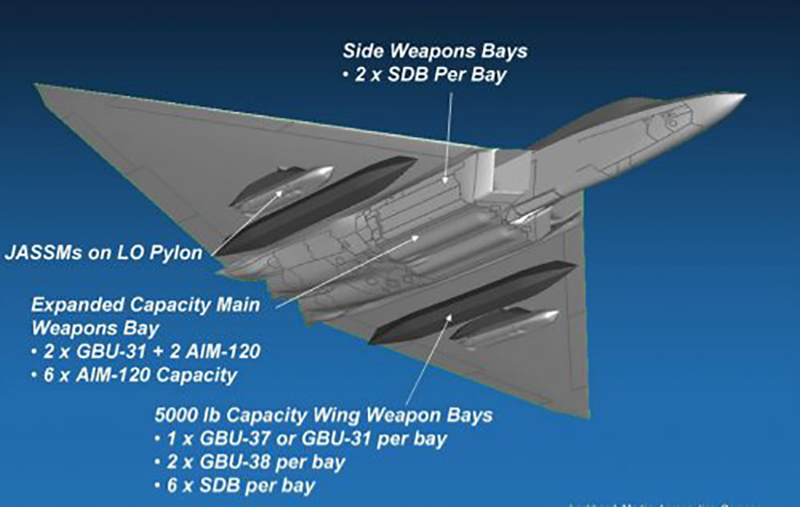
Still, I would put the possibility of these being weapons carriage pods a bit farther down the list in terms of likely explanations. With that being said, we may be seeing something of a highly adaptable form factor that can be applied to a number of capability sets for the Raptor’s future use. From an IRST to an electronic attack to even possibly carrying more weapons. By creating a fully tested form factor, it makes it very easy to adapt the pod to many uses. We are seeing this same technique on other programs, such as the P-8 Poseidon.
Regardless, it seems clear that work to rapidly advance the F-22’s capabilities to face a more capable peer state foe is underway, maybe more so than most realize at this time. It’s always possible that this configuration being tested will end up as a developmental dead-end, or other priorities will supersede its capabilities being deployed across the small but potent Raptor fleet. But considering how ‘finished’ these pods look for the test environment, we could be seeing a lot more of them soon.
Author’s note: A big thanks to James Reeder for sharing his F-22 shots with us. He has some gorgeous aviation images on his Instagram, make sure to follow him!
Contact the author: Tyler@thedrive.com
